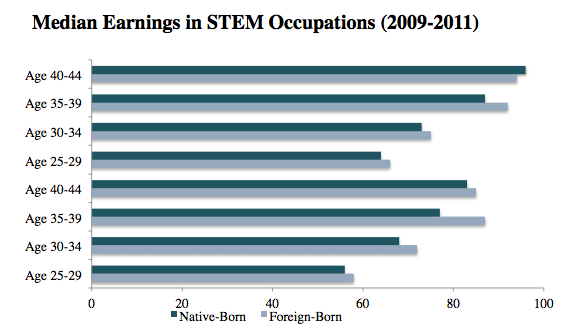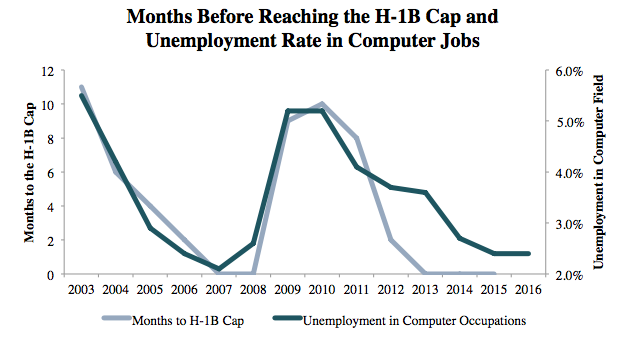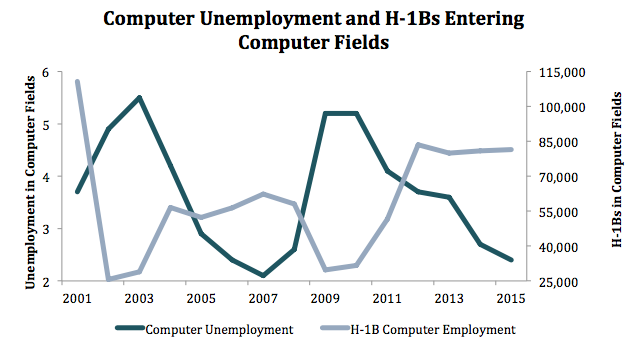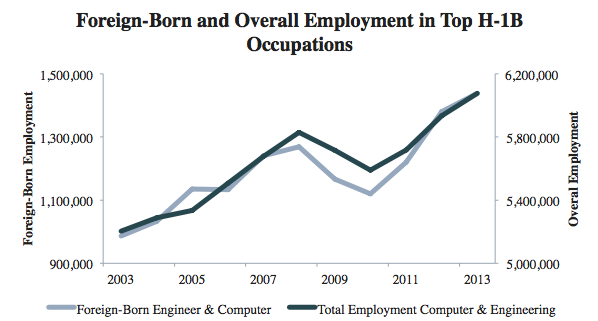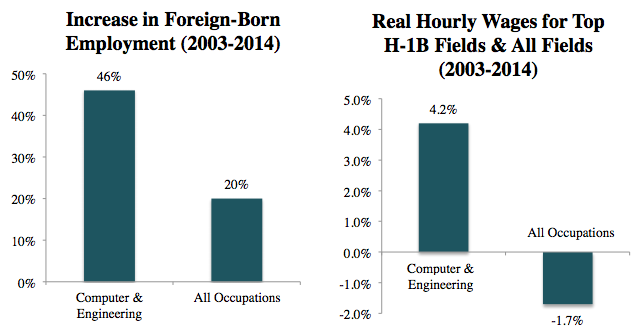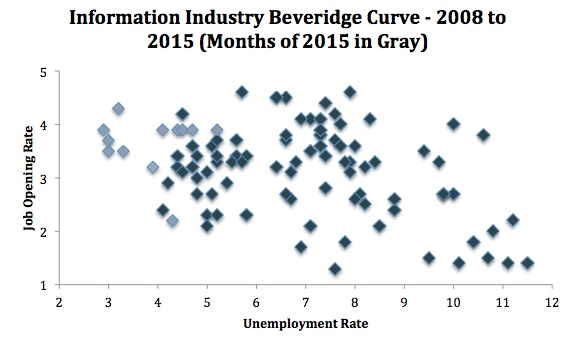A pdf version of this statement is available here.
Statement for the Record of the Niskanen Center[*]
Submitted to
The Senate Committee on the Judiciary’s Subcommittee on Immigration
Hearing on
“The Impact of High-Skilled Immigration on U.S. Workers”
February 25, 2016
High-skilled immigration has unequivocally positive benefits for U.S. workers. These benefits are being questioned because of several recent incidents in which foreign-born workers on H-1B temporary visas replaced American workers. These incidents do not reflect the general trends in H-1B industries. Overall, the impact of the H-1B visa has been positive, and these rare incidents should be addressed through market-based reforms that protect immigrant rights, increase their bargaining power, and allow Americans to compete on an even playing field.
High skilled foreign workers have higher wages than native-born Americans
Perhaps the single most significant reason to doubt the theory that high skilled immigrants act as cheaper alternatives to American workers is that they receive higher pay than native-born workers. It simply is not possible that foreign-born workers undercut the wages of native-born workers if they are more highly paid.
Foreign workers with a bachelor’s degree or higher actually had 3 percent higher median 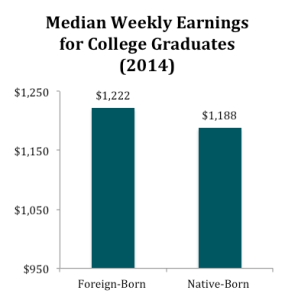 earnings in 2014 than native-born workers, which discredits the idea that foreign workers are “undermining” the wages of Americans, according to the Bureau of Labor Statistics (BLS).[1] Foreign-born college-educated workers also recorded higher earnings than their U.S.-born counterparts in 2013.
earnings in 2014 than native-born workers, which discredits the idea that foreign workers are “undermining” the wages of Americans, according to the Bureau of Labor Statistics (BLS).[1] Foreign-born college-educated workers also recorded higher earnings than their U.S.-born counterparts in 2013.
Looking specifically at science, technology, engineering, and mathematics (STEM) fields, economists Gordon Hanson of UC San Diego and Matthew Slaughter of Dartmouth compared wages of native and foreign workers across a three-year sample from 2009-2011. The economists found that foreign STEM workers in their prime generally earned slightly more than native-born, but that overall, there was no statistically significant difference between the groups.[2] These workers cannot undermine the wages of native-born workers when they are paid more.
American firms hire H-1B workers when they expand employment overall.
If H-1B visas were used primarily as a way of cutting labor costs, we would expect that firms would request visas when they are, in fact, cutting labor costs through layoffs. But this is not the case. The demand for H-1B visas—the pace of H-1B requests as measured by how quickly the cap on H-1B visas is filled—increases as American companies drive up overall employment in the top H-1B field, computer and tech jobs (which account for 60 percent of all H-1B employment).[3]
Since 2003, when the base cap on H-1B visas was cut from 195,000 to 65,000 visas, there has been a strong correlation between a lower unemployment rate for computer and mathematical occupations and a faster pace for H-1B applications. That is, simply by knowing the unemployment rate for computer jobs, we can predict 80 percent of the variation in the rate of new H-1B visa requests. From 2003 to 2015, a one percent decrease in unemployment in those occupations is associated with a 3.3 month decrease before the H-1B cap is reached—a significant increase in demand for H-1Bs.
Another way to look at whether H-1Bs are used to displace Americans is to compare H-1Bs issued to persons in computer fields to the unemployment rate in computer jobs.[4] Unemployment in computer and tech jobs falls as H-1Bs enter those fields. In fact, as is visible on the graph below, this relationship is constrained because H-1Bs have an artificial limit that prevents an expansion in H-1B employment that is proportional to the drop in unemployment.
The idea that foreign-born H-1Bs are used as cheaper substitutes for American workers is further undercut by the fact that the employment of high-skilled foreign-born workers follows the overall employment trend in those fields. From 2003 to 2013, foreign-born workers in the top H-1B fields—engineering, architectural, computer, and mathematical occupations—had a strong positive correlation to the overall employment in those fields.
As before, companies are not turning to foreign workers when they are laying off Americans and cutting labor costs. By knowing the number of foreign workers employed in the top H-1B fields, we can predict 90 percent of the variation in the overall employment in those fields. The entrance of a single foreign-born worker into the top H-1B fields is associated with an increase of nearly two new jobs overall.[5]
Despite tens of thousands of new H-1Bs entering engineering, architectural, computer, and mathematical fields each year, real median hourly wages for these top H-1B fields have increased by 4.2 percent from 2003 to 2013.[6] Wages for all other occupations declined by almost 2 percent over that time, meaning that wages for the top H-1B occupations grew nearly 6 percent more than wages for all other occupations.[7]
Despite an almost 50 percent increase in the number of foreign-born workers in the top H-1B occupations from 2003 to 2013, their wages continued to rise.[8] The rest of the economy saw less growth in the number of foreign-born workers, but wages dropped. While by themselves these facts do not prove that H-1Bs or foreign workers are responsible for rising wages in top H-1B fields, it does invalidate the claim that H-1Bs cause wages to decline. Just as importantly, it demonstrates a key point for proponents of the H-1B: the value of workers in these fields is rising.
Information industry has tightest labor market since 2007
In general, fields that H-1Bs enter are seeing tightening labor markets and rising wages. The availability of workers is best seen in the ratio of the unemployment rate to the job openings rate in the current year compared to prior years in the industry. Graphing this information creates a Beveridge curve. The ratio reflects the two best measures of the labor market health, and the curve shows what a tight or loose labor market looks like in the industry: the tighter the labor market, the higher and further to the left the point will appear on the curve.
Above is the Beveridge curve for the information industry based on data from the Bureau of Labor Statistics on the industry from 2001 to 2015.[9] Each highlighted point is a month in 2015. As can be seen, the toughest months for employers in the information industry to find employment from 2008 to 2016 were in 2015. In fact, 2015 had nine of the ten months with the tightest labor markets—the other was in 2014.
H-1B visas create jobs for U.S.-born workers
What is true for the general economy is true for specific H-1B employers. They hire H-1Bs primarily when they are expanding. In 2006, the National Foundation for American Policy analyzed the H-1B filings for technology companies in the S&P 500 and their employment figures for 2002 to 2005. Its report found “a positive and statistically significant association between the number of positions requested in H-1B labor condition applications and the percentage change in total employment.”[10]
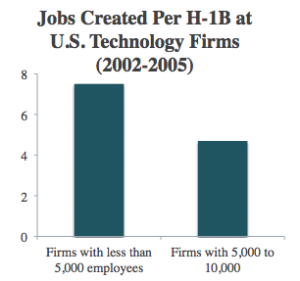 In other words, the general trend holds true at the firm level as well. Specifically the report found that each H-1B request by large tech companies is associated with an increase of 67 employees overall. The authors used a model that controlled for general market conditions to see if firms that hired H-1Bs were able to hire more non-H-1Bs than their competitors. They found that H-1B hiring firms with 5,000 or more employees increased employment by 5 new hires for each H-1B request more than what the general market conditions would predict. Firms with 5,000 or fewer employees added 7 additional hires. Firms that employ H-1Bs are actually hiring more non-H-1Bs than firms that don’t.
In other words, the general trend holds true at the firm level as well. Specifically the report found that each H-1B request by large tech companies is associated with an increase of 67 employees overall. The authors used a model that controlled for general market conditions to see if firms that hired H-1Bs were able to hire more non-H-1Bs than their competitors. They found that H-1B hiring firms with 5,000 or more employees increased employment by 5 new hires for each H-1B request more than what the general market conditions would predict. Firms with 5,000 or fewer employees added 7 additional hires. Firms that employ H-1Bs are actually hiring more non-H-1Bs than firms that don’t.
Policymakers should avoid the faulty distinction between an entrepreneur who “creates jobs” and a worker who merely “takes jobs.” The reality is that a high-skilled worker can act as an entrepreneur within the company. By raising production and productivity in the firm, the skills of an H-1B allow the firm to expand and hire more workers to handle new tasks related to the increased productivity. A new invention, product, or process creates jobs whether the inventor is an H-1B temporary worker or an immigrant entrepreneur.
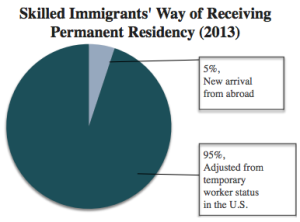 It is wrong to draw a sharp distinction between H-1Bs and foreign-born permanent residents who can start businesses. In 2013, like prior years, 95 percent of all high-skilled immigrants—employment-based immigrant workers with at least a bachelor’s degree—adjusted their status from “temporary” to “permanent” in the United States.[11] The H-1B visa has long been a gateway into the United States for immigrant entrepreneurs who create businesses that employ Americans.
It is wrong to draw a sharp distinction between H-1Bs and foreign-born permanent residents who can start businesses. In 2013, like prior years, 95 percent of all high-skilled immigrants—employment-based immigrant workers with at least a bachelor’s degree—adjusted their status from “temporary” to “permanent” in the United States.[11] The H-1B visa has long been a gateway into the United States for immigrant entrepreneurs who create businesses that employ Americans.
Recent research by economists confirms that high-skilled immigrants are having a positive impact on the wages and employment of Americans. Economist Charles Jones of Stanford University found that scientists and engineers foreign 50 percent of all total factor productivity growth from 1990 to 2002. In 2014, economists Giovanni Peri, Kevin Shih, and Chad Sparber used this number to conclude that because foreign-born workers accounted for 80 percent of the growth in employment in STEM fields from 1990 to 2010, they may also have accounted for as much as 40 percent of all productivity growth in the United States.[12]
In 2014, the economists compared this rough estimate to the effects of 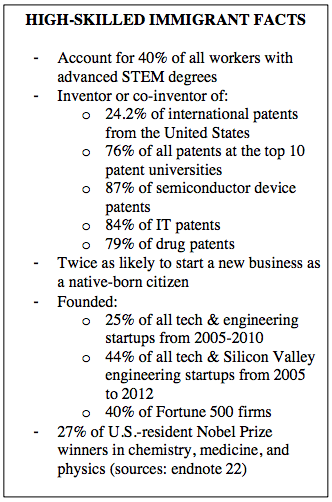 foreign workers on U.S. cities. Using cross-city panel regressions, they found that a one percent increase in foreign STEM workers as a share of total employment raises the wages of college-educated natives by 7 to 8 percent in a given city.[13]
foreign workers on U.S. cities. Using cross-city panel regressions, they found that a one percent increase in foreign STEM workers as a share of total employment raises the wages of college-educated natives by 7 to 8 percent in a given city.[13]
These results built on prior research that found that H-1Bs significantly increase the number of patent filings by U.S. firms with no reduction in the number of patents filed by native-born inventors.[14] Other economists have concluded that foreign workers increase the productivity of American workers, finding that a one percent increase in foreign-born college graduates resulted in a 15 percent increase in patents per capita from 1950 to 2000.[15]
In other words, the H-1Bs are increasing innovation without replacing jobs and innovation from Americans. The economic research finding positive effects for H-1Bs is overwhelming, and there has yet to be any academic research that finds that high-skilled immigrants decrease patenting, production, productivity, or innovation.[16] The United States has much to gain and nothing to lose by increasing high-skilled migration.
Responses to occasional H-1B abuse should focus on greater H-1B bargaining power
Despite the evidence that H-1Bs are primarily requested to expand production at American companies, not to displace American workers, some rare cases have occurred where H-1Bs have been mistreated or paid below market wages relative to American workers. Congress can take actions to stop such abuses without eliminating the program or making it unusable with burdensome government regulations.
- Let H-1Bs leave bad employers. An unscrupulous employer can only get away with paying an H-1B less than an American for the same work because the American can walk away from the negotiation, but H-1Bs cannot without losing their legal status. If the H-1B is without a sponsoring employer for even a single day, he or she is out of status. H-1Bs should be given a grace period of up to 60 days to find a new sponsoring employer. This would empower them to protect themselves while also making them less attractive to an employer who would seek to use the H-1B to undercut the wages of an American worker.
- Let H-1Bs stay in the green card line if they change employers. If an employer applies for a green card for the worker, an H-1B cannot leave the employer without giving up their spot in the green card line. This provides a huge incentive for them to keep a lousy job even if a different employer would pay them more or treat them better. H-1Bs should be able to keep their place in the green card line even if they change jobs.
- End the low H-1B cap. A counterintuitive way to combat H-1B abuses is to make more visas available. Due to the low cap, a lottery is used to decide which companies can hire H-1Bs. Like a raffle, the winners are the employers who submit the most applications, not necessarily the employers who have the greatest need (as measured in pay). For example, even though Microsoft pays its H-1B employees 46 percent higher than the median salary for employers in the same city and industry, a third of its H-1B requests could not be filled in 2014.[17] The H-1B lottery funnels workers toward a random assortment of employers, not the ones that they would naturally choose in a free market. Without the cap, workers would not have to choose between a visa and a good employer.
- Raise the green card limits. Green cards allow successful H-1Bs to transition away from temporary status to permanent residency. Legal permanent residents can walk away from a negotiation, join a union, and work for any employer they want, which means that businesses have no reason to prefer them to American workers. Just as important, green card holders can create their own businesses that can employ even more Americans.
More government regulation is not the answer to protect H-1Bs and Americans from abusive practices. The federal government already regulates the wages and working conditions of H-1B employers, and its Fraud Detection and National Security Directorate annually conducts more than 15,000 random onsite inspections of employers without notice.[18] Government inspectors will never be as effective of a tool at protecting workers as empowering the workers to protect themselves.
Conclusion
The benefits of H-1B workers are indisputable. H-1Bs are associated with greater economic growth, innovation, employment, and wages for Americans. The preponderance of evidence clearly indicates that H-1Bs do not harm Americans: H-1Bs create new and better opportunities for them.
Congress has the tools to address the rare cases of H-1B abuse without gutting the program. It should seek to empower H-1Bs to protect themselves from abuse, while also making more H-1Bs available. High-skilled immigrant workers have contributed greatly to America’s competitiveness in the past and, barring unnecessary government restriction, will continue to do so in the future.
[*] The Niskanen Center is a libertarian 501(c)(3) nonprofit think tank located in Washington, D.C. founded in 2014. https://www.niskanencenter.org/about/
[1] Bureau of Labor Statistics. “Foreign-Born Workers: Labor Force Characteristics—2014.” P. 13. http://www.bls.gov/news.release/archives/forbrn_05222013.pdf
[2] Hanson, Gordon, and Matthew Slaughter. “Talent, Immigration, and U.S. Economic Competitiveness.” University of California San Diego, 2013. http://irps.ucsd.edu/assets/001/504703.pdf.
[3] In 2012. Department of Homeland Security. “Characteristics of H1B Specialty Occupation Workers.” 2013. Accessed March 28, 2015. P. 13. http://www.uscis.gov/sites/default/files/USCIS/Resources/Reports%20and%20Studies/H-1B/h1b-fy-12-characteristics.pdf
[4] U.S. Citizenship and Immigration Services. “Reports and Studies – USCIS Program Reports H-1B & H-2B.” https://www.uscis.gov/tools/reports-studies/reports-and-studies
Bureau of Labor Statistics. “BLS Data Viewer – Unemployment Rate – Computer and Mathematical Occupations.” http://beta.bls.gov/dataViewer/view/timeseries/LNU04034021
[5] Bier, David. “H-1Bs Don’t Replace U.S. Workers.” Niskanen Center. April 6, 2015. https://www.niskanencenter.org/wp-content/uploads/old_uploads/2015/04/NiskanenH1BsDontReplaceUSWorkers.pdf
[6] Weighted average of the median wage for the two occupational categories adjusted for inflation (CPI). Bureau of Labor Statistics. “Occupational Employment Statistics.” Accessed March 28, 2015. http://www.bls.gov/oes/tables.htm
[7] Nowrasteh, Alex. “Is There a STEM Worker “Shortage”?” Cato Institute. May 21, 2014. http://www.cato.org/blog/there-stem-worker-shortage
[8] Bureau of Labor Statistics. “Foreign-Born Workers: Labor Force Characteristics.” Accessed March 25, 2015. http://www.bls.gov/schedule/archives/all_nr.htm#FORBRN
[9] Bureau of Labor Statistics. “Data Retrieval: Labor Force Statistics – Information.”
http://www.bls.gov/webapps/legacy/cpsatab14.htm
Bureau of Labor Statistics. “Job Openings and Labor Turnover Survey – Databases.”
[10] National Foundation of American Policy. “H-1B Visas by the Numbers.” March 2008. Accessed March 27, 2015. http://www.nfap.com/pdf/080311h1b.pdf
[11] Table 7: Department of Homeland Security. “Yearbook of Immigration Statistics: 2013.” Accessed March 27, 2015. http://www.dhs.gov/yearbook-immigration-statistics-2013-lawful-permanent-residents
[12] Peri, Giovanni, Chad Sparber, and Kevin Shih. “How Highly Educated Immigrants Raise Native Wages.” Center for Economic Policy Research, 2014. http://www.voxeu.org/article/how-highly-educated-immigrants-raise-native-wages.
[13] Peri, Giovanni, Chad Sparber, and Kevin Shih. “Foreign STEM Workers and Native Wages and Employment in U.S. Cities.” National Bureau of Economic Research, Working Paper No. 20093, 2014. http://www.nber.org/papers/w20093
[14] William Kerr, and Lincoln, William. “The Supply Side of Innovation: H-1B Visa Reforms and US Ethnic Invention.” Harvard Business School, Working Paper 09-005, 2008. http://www.hbs.edu/faculty/Publication%20Files/09-005.pdf
[15] Hunt, Jennifer, and Gauthier-Loiselle, Marjolaine. “How Much Does Immigration Boost Innovation?” National Bureau of Economic Research, Working Paper No. 14312, 2008. http://www.nber.org/papers/w14312
For sources for “Facts about High Skilled Immigrants,” see note 23 and note 16.
[16] Nowrasteh. Alex. “Boost Highly Skilled Immigration.” Cato Institute, 2014. http://www.cato.org/publications/cato-online-forum/boost-highly-skilled-immigration
[17] “H-1B Visa LCAs and Green Card LCs for Microsoft Corporation.” Find the Data. Accessed March 25, 2015. http://foreign-employment.findthedata.com/l/2a3348/Microsoft-Corporation.
“Number of employees at Microsoft Corporation from 2005 to 2014 (in 1,000s).” Statista. Accessed March 25, 2015. http://www.statista.com/statistics/273475/number-of-employees-at-the-microsoft-corporation-since-2005/
[18] United States Citizenship and Immigration Service. “Administrative Site Visit and Verification Program.” 2014. Accessed: March 27, 2015. http://www.uscis.gov/about-us/directorates-and-program-offices/fraud-detection-and-national-security/administrative-site-visit-and-verification-program
U.S. Chamber of Commerce. “Statement of the U.S. Chamber of Commerce on Senate Judiciary Committee hearing on Immigration Reforms Needed to Protect Skilled American Workers.” March 17, 2015. Accessed: March 27, 2015.
